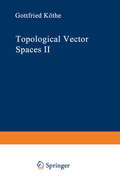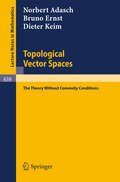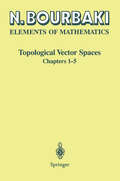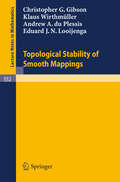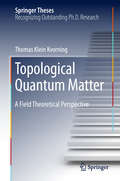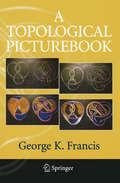- Table View
- List View
Topologie (Springer-Lehrbuch)
by Klaus JänichAus den Rezensionen: "Was das Buch vor allem auszeichnet, ist die unkonventionelle Darstellungsweise. Hier wird Mathematik nicht im trockenen Definition-Satz-Beweis-Stil geboten, sondern sie wird dem Leser pointiert und mit viel Humor schmackhaft gemacht. In ungewöhnlich fesselnder Sprache geschrieben, ist die Lektüre dieses Buches auch ein belletristisches Vergnügen. Fast 200 sehr instruktive und schöne Zeichnungen unterstützen das Verständnis, motivieren die behandelten Aussagen, modellieren die tragenden Beweisideen heraus. ... Ungewöhnlich ist auch das Register, das unter jedem Stichwort eine Kurzdefinition enthält und somit umständliches Nachschlagen erspart". Wiss. Zeitschrift der TU Dresden Jetzt in der sechsten, durchgesehenen Auflage!
Topologie (vieweg studium; Aufbaukurs Mathematik #42)
by Erich OssaDas Ziel des Buches ist eine umfassende Einführung sowohl in die geometrische wie die algebraische Topologie. Dabei werden lediglich gute Kenntnisse aus dem Grundstudium der Mathematik vorausgesetzt, die über die Analysis und Lineare Algebra kaum hinausgehen; alle weiteren Hilfsmittel, wie die Grundbegriffe der mengentheoretischen Topologie, die Theorie der topologischen Gruppen und die elementare homologische Algebra, werden ebenfalls ausführlich dargestellt. Im Vordergrund stehen jedoch nicht die hieraus hervorgehenden technischen Apparate, die vielfach eine nur schwer zu überwindende Hürde beim Studium der Topologie bilden, sondern die geometrischen Fragestellungen, die erst den Anlass zu ihrer Entwicklung gaben.
Topologie: Ein Lesebuch von den elementaren Grundlagen bis zur Homologie und Kohomologie
by Fridtjof ToenniessenDieses Buch spannt einen Bogen von den elementaren Grundlagen über fortgeschrittene Themen bis hin zu tiefer liegenden Meilensteinen, die im 20. Jahrhundert Furore gemacht haben. Der Text ist durchgängig einfach geschrieben, braucht nur wenig Vorwissen und ist gut geeignet ab etwa dem dritten Semester eines mathematischen Bachelorstudiums. Bei der Lektüre erfahren Sie, liebe Leser, auch hie und da historische Fakten oder werden in die Gedankengänge von Mathematikern versetzt, um die Entstehung der Theorie Schritt für Schritt nacherleben zu können -- fast wie in einem Lesebuch. Dabei geht es naturgemäß nicht immer geradeaus, manchmal führe ich Sie auf Holzwege, die einerseits zum Nachdenken und zu einer kritischen Reflexion anregen, andererseits aber auch zeigen sollen, dass die Definitionen nicht einfach vom Himmel gefallen sind, sondern sich organisch entwickelt haben.Im Text werden Sie immer wieder angeregt, einfache Dinge anhand kleiner Aufgaben selbst zu überlegen, um sich aktiv mit dem Inhalt zu beschäftigen. Separate Übungen sind daher nicht vorgesehen, viele konkrete Beispiele und über 600 Abbildungen runden den Stoff ab.
Topological Vector Spaces II (Grundlehren der mathematischen Wissenschaften #237)
by Gottfried KötheIn the preface to Volume One I promised a second volume which would contain the theory of linear mappings and special classes of spaces im portant in analysis. It took me nearly twenty years to fulfill this promise, at least to some extent. To the six chapters of Volume One I added two new chapters, one on linear mappings and duality (Chapter Seven), the second on spaces of linear mappings (Chapter Eight). A glance at the Contents and the short introductions to the two new chapters will give a fair impression of the material included in this volume. I regret that I had to give up my intention to write a third chapter on nuclear spaces. It seemed impossible to include the recent deep results in this field without creating a great further delay. A substantial part of this book grew out of lectures I held at the Mathematics Department of the University of Maryland· during the academic years 1963-1964, 1967-1968, and 1971-1972. I would like to express my gratitude to my colleagues J. BRACE, S. GOLDBERG, J. HORVATH, and G. MALTESE for many stimulating and helpful discussions during these years. I am particularly indebted to H. JARCHOW (Ziirich) and D. KEIM (Frankfurt) for many suggestions and corrections. Both have read the whole manuscript. N. ADASCH (Frankfurt), V. EBERHARDT (Miinchen), H. MEISE (Diisseldorf), and R. HOLLSTEIN (Paderborn) helped with important observations.
Topological Vector Spaces I (Grundlehren der mathematischen Wissenschaften #159)
by Gottfried KötheIt is the author's aim to give a systematic account of the most im portant ideas, methods and results of the theory of topological vector spaces. After a rapid development during the last 15 years, this theory has now achieved a form which makes such an account seem both possible and desirable. This present first volume begins with the fundamental ideas of general topology. These are of crucial importance for the theory that follows, and so it seems necessary to give a concise account, giving complete proofs. This also has the advantage that the only preliminary knowledge required for reading this book is of classical analysis and set theory. In the second chapter, infinite dimensional linear algebra is considered in comparative detail. As a result, the concept of dual pair and linear topologies on vector spaces over arbitrary fields are intro duced in a natural way. It appears to the author to be of interest to follow the theory of these linearly topologised spaces quite far, since this theory can be developed in a way which closely resembles the theory of locally convex spaces. It should however be stressed that this part of chapter two is not needed for the comprehension of the later chapters. Chapter three is concerned with real and complex topological vector spaces. The classical results of Banach's theory are given here, as are fundamental results about convex sets in infinite dimensional spaces.
Topological Vector Spaces and Their Applications (Springer Monographs in Mathematics)
by V. I. Bogachev O. G. SmolyanovThis book gives a compact exposition of the fundamentals of the theory of locally convex topological vector spaces. Furthermore it contains a survey of the most important results of a more subtle nature, which cannot be regarded as basic, but knowledge which is useful for understanding applications. Finally, the book explores some of such applications connected with differential calculus and measure theory in infinite-dimensional spaces. These applications are a central aspect of the book, which is why it is different from the wide range of existing texts on topological vector spaces. Overall, this book develops differential and integral calculus on infinite-dimensional locally convex spaces by using methods and techniques of the theory of locally convex spaces. The target readership includes mathematicians and physicists whose research is related to infinite-dimensional analysis.
Topological Vector Spaces: The Theory Without Convexity Conditions (Lecture Notes in Mathematics #639)
by Norbert Adasch Bruno Ernst Dieter KeimTopological Vector Spaces: Chapters 1–5
by N. BourbakiThis is a softcover reprint of the 1987 English translation of the second edition of Bourbaki's Espaces Vectoriels Topologiques. Much of the material has been rearranged, rewritten, or replaced by a more up-to-date exposition, and a good deal of new material has been incorporated in this book, reflecting decades of progress in the field.
Topological Vector Spaces (Graduate Texts in Mathematics #3)
by H.H. SchaeferIntended as a systematic text on topological vector spaces, this text assumes familiarity with the elements of general topology and linear algebra. Similarly, the elementary facts on Hilbert and Banach spaces are not discussed in detail here, since the book is mainly addressed to those readers who wish to go beyond the introductory level. Each of the chapters is preceded by an introduction and followed by exercises, which in turn are devoted to further results and supplements, in particular, to examples and counter-examples, and hints have been given where appropriate. This second edition has been thoroughly revised and includes a new chapter on C^* and W^* algebras.
Topological Vector Spaces (Graduate Texts in Mathematics #3)
by H.H. SchaeferThe present book is intended to be a systematic text on topological vector spaces and presupposes familiarity with the elements of general topology and linear algebra. The author has found it unnecessary to rederive these results, since they are equally basic for many other areas of mathematics, and every beginning graduate student is likely to have made their acquaintance. Simi larly, the elementary facts on Hilbert and Banach spaces are widely known and are not discussed in detail in this book, which is mainly addressed to those readers who have attained and wish to get beyond the introductory level. The book has its origin in courses given by the author at Washington State University, the University of Michigan, and the University of Tiibingen in the years 1958-1963. At that time there existed no reasonably complete text on topological vector spaces in English, and there seemed to be a genuine need for a book on this subject. This situation changed in 1963 with the appearance of the book by Kelley, Namioka et al. [1] which, through its many elegant proofs, has had some influence on the final draft of this manuscript. Yet the two books appear to be sufficiently different in spirit and subject matter to justify the publication of this manuscript; in particular, the present book includes a discussion of topological tensor products, nuclear spaces, ordered topological vector spaces, and an appendix on positive operators.
Topological Structure of the Solution Set for Evolution Inclusions (Developments in Mathematics #51)
by Yong Zhou Rong-Nian Wang Li PengThis book systematically presents the topological structure of solution sets and attractability for nonlinear evolution inclusions, together with its relevant applications in control problems and partial differential equations. It provides readers the background material needed to delve deeper into the subject and explore the rich research literature. In addition, the book addresses many of the basic techniques and results recently developed in connection with this theory, including the structure of solution sets for evolution inclusions with m-dissipative operators; quasi-autonomous and non-autonomous evolution inclusions and control systems; evolution inclusions with the Hille-Yosida operator; functional evolution inclusions; impulsive evolution inclusions; and stochastic evolution inclusions. Several applications of evolution inclusions and control systems are also discussed in detail. Based on extensive research work conducted by the authors and other experts over the past four years, the information presented is cutting-edge and comprehensive. As such, the book fills an important gap in the body of literature on the structure of evolution inclusions and its applications.
Topological Structure and Analysis of Interconnection Networks (Network Theory and Applications #7)
by Junming XuThe advent of very large scale integrated circuit technology has enabled the construction of very complex and large interconnection networks. By most accounts, the next generation of supercomputers will achieve its gains by increasing the number of processing elements, rather than by using faster processors. The most difficult technical problem in constructing a supercom puter will be the design of the interconnection network through which the processors communicate. Selecting an appropriate and adequate topological structure of interconnection networks will become a critical issue, on which many research efforts have been made over the past decade. The book is aimed to attract the readers' attention to such an important research area. Graph theory is a fundamental and powerful mathematical tool for de signing and analyzing interconnection networks, since the topological struc ture of an interconnection network is a graph. This fact has been univer sally accepted by computer scientists and engineers. This book provides the most basic problems, concepts and well-established results on the topological structure and analysis of interconnection networks in the language of graph theory. The material originates from a vast amount of literature, but the theory presented is developed carefully and skillfully. The treatment is gen erally self-contained, and most stated results are proved. No exercises are explicitly exhibited, but there are some stated results whose proofs are left to the reader to consolidate his understanding of the material.
Topological Stability of Smooth Mappings (Lecture Notes in Mathematics #552)
by C.G. Gibson K. Wirthmüller A.A. Du Plessis E.J.N. LooijengaTopological Spaces: From Distance to Neighborhood (Undergraduate Texts in Mathematics)
by Gerard Buskes Arnoud van Rooijgentle introduction to the subject, leading the reader to understand the notion of what is important in topology with regard to geometry. Divided into three sections - The line and the plane, Metric spaces and Topological spaces -, the book eases the move into higher levels of abstraction. Students are thereby informally assisted in learning new ideas while remaining on familiar territory. The authors do not assume previous knowledge of axiomatic approach or set theory. Similarly, they have restricted the mathematical vocabulary in the book so as to avoid overwhelming the reader, and the concept of convergence is employed to allow students to focus on a central theme while moving to a natural understanding of the notion of topology. The pace of the book is relaxed with gradual acceleration: the first nine sections form a balanced course in metric spaces for undergraduates while also containing ample material for a two-semester graduate course. Finally, the book illustrates the many connections between topology and other subjects, such as analysis and set theory, via the inclusion of "Extras" at the end of each chapter presenting a brief foray outside topology.
Topological Social Choice
by Geoffrey HealThe origins of this volume can be traced back to a conference on "Ethics, Economic and Business" organized by Columbia Busi ness School in March of 1993, and held in the splendid facilities of Columbia's Casa Italiana. Preliminary versions of several of the papers were presented at that meeting. In July 1994 the Fields Institute of Mathematical Sciences sponsored a workshop on "Geometry, Topology and Markets": additional papers and more refined versions of the original papers were presented there. They were published in their present versions in Social Choice and Wel fare, volume 14, number 2, 1997. The common aim of these workshops and this volume is to crystallize research in an area which has emerged rapidly in the last fifteen years, the area of topological approaches to social choice and the theory of games. The area is attracting increasing interest from social choice theorists, game theorists, mathematical econ omists and mathematicians, yet there is no authoritative collection of papers in the area. Nor is there any surveyor book to give a perspective and act as a guide to the issues in and contributions to this new area. One of the two aims of this volume is in some measure to play this role: the other aim is of course to present interesting and surprising new results.
Topological Signal Processing (Mathematical Engineering)
by Michael RobinsonSignal processing is the discipline of extracting information from collections of measurements. To be effective, the measurements must be organized and then filtered, detected, or transformed to expose the desired information. Distortions caused by uncertainty, noise, and clutter degrade the performance of practical signal processing systems.In aggressively uncertain situations, the full truth about an underlying signal cannot be known. This book develops the theory and practice of signal processing systems for these situations that extract useful, qualitative information using the mathematics of topology -- the study of spaces under continuous transformations. Since the collection of continuous transformations is large and varied, tools which are topologically-motivated are automatically insensitive to substantial distortion. The target audience comprises practitioners as well as researchers, but the book may also be beneficial for graduate students.
Topological Rings Satisfying Compactness Conditions (Mathematics and Its Applications #549)
by M. UrsulIntroduction In the last few years a few monographs dedicated to the theory of topolog ical rings have appeared [Warn27], [Warn26], [Wies 19], [Wies 20], [ArnGM]. Ring theory can be viewed as a particular case of Z-algebras. Many general results true for rings can be extended to algebras over commutative rings. In topological algebra the structure theory for two classes of topological algebras is well developed: Banach algebras; and locally compact rings. The theory of Banach algebras uses results of Banach spaces, and the theory of locally compact rings uses the theory of LCA groups. As far as the author knows, the first papers on the theory of locally compact rings were [Pontr1]' [J1], [J2], [JT], [An], lOt], [K1]' [K2]' [K3], [K4], [K5], [K6]. Later two papers, [GS1,GS2]appeared, which contain many results concerning locally compact rings. This book can be used in two w.ays. It contains all necessary elementary results from the theory of topological groups and rings. In order to read these parts of the book the reader needs to know only elementary facts from the theories of groups, rings, modules, topology. The book consists of two parts.
Topological Quantum Matter: A Field Theoretical Perspective (Springer Theses)
by Thomas Klein KvorningThis book offers a theoretical description of topological matter in terms of effective field theories, and in particular topological field theories, focusing on two main topics: topological superconductors and topological insulators.Even though there is vast literature on these subjects, the book fills an important gap by providing a concise introduction to both topological order and symmetry-protected phases using a modern mathematical language, and developing the theoretical concepts by highlighting the physics and the physical properties of the systems. Further, it discusses in detail the topological interactions for topologically ordered matter, and the response to smooth external fields for symmetry protected matter. The book also covers more specialized topics that cannot be found elsewhere. Specifically, the response of superconductors to geometry, including the newly discovered geo-Meissner effect; and a correction to the usual Meissner effect, only present in the topologically interesting chiral superconductors.
Topological Quantum Field Theory and Four Manifolds (Mathematical Physics Studies #25)
by Jose Labastida Marcos MarinoThe emergence of topological quantum ?eld theory has been one of the most important breakthroughs which have occurred in the context of ma- ematical physics in the last century, a century characterizedbyindependent developments of the main ideas in both disciplines, physics and mathematics, which has concluded with two decades of strong interaction between them, where physics, as in previous centuries, has acted as a source of new mat- matics. Topological quantum ?eld theories constitute the core of these p- nomena, although the main drivingforce behind it has been the enormous e?ort made in theoretical particle physics to understand string theory as a theory able to unify the four fundamental interactions observed in nature. These theories set up a new realm where both disciplines pro?t from each other. Although the most striking results have appeared on the mathema- calside,theoreticalphysicshasclearlyalsobene?tted,sincethecorresponding developments have helped better to understand aspects of the fundamentals of ?eld and string theory.
Topological Quantum Field Theories from Subfactors
by Vijay KodiyalamPure mathematicians have only recently begun a rigorous study of topological quantum field theories (TQFTs). Ocneanu, in particular, showed that subfactors yield TQFTs that complement the Turaev-Viro construction. Until now, however, it has been difficult to find an account of this work that is both detailed and accessible.Topological Quant
Topological Quantum Field Theories from Subfactors
by Vijay KodiyalamPure mathematicians have only recently begun a rigorous study of topological quantum field theories (TQFTs). Ocneanu, in particular, showed that subfactors yield TQFTs that complement the Turaev-Viro construction. Until now, however, it has been difficult to find an account of this work that is both detailed and accessible.Topological Quant
Topological Properties of Spaces of Continuous Functions (Lecture Notes in Mathematics #1315)
by Robert A. McCoy Ibula NtantuThis book brings together into a general setting various techniques in the study of the topological properties of spaces of continuous functions. The two major classes of function space topologies studied are the set-open topologies and the uniform topologies. Where appropriate, the analogous theorems for the two major classes of topologies are studied together, so that a comparison can be made. A chapter on cardinal functions puts characterizations of a number of topological properties of function spaces into a more general setting: some of these results are new, others are generalizations of known theorems. Excercises are included at the end of each chapter, covering other kinds of function space topologies. Thus the book should be appropriate for use in a classroom setting as well as for functional analysis and general topology. The only background needed is some basic knowledge of general topology.
A Topological Picturebook
by George K. FrancisPraise for George Francis's A Topological Picturebook: Bravo to Springer for reissuing this unique and beautiful book! It not only reminds the older generation of the pleasures of doing mathematics by hand, but also shows the new generation what ``hands on'' really means. - John Stillwell, University of San Francisco The Topological Picturebook has taught a whole generation of mathematicians to draw, to see, and to think. - Tony Robbin, artist and author of Shadows of Reality: The Fourth Dimension in Relativity, Cubism, and Modern Thought The classic reference for how to present topological information visually, full of amazing hand-drawn pictures of complicated surfaces. - John Sullivan, Technische Universitat Berlin A Topological Picturebook lets students see topology as the original discoverers conceived it: concrete and visual, free of the formalism that burdens conventional textbooks. - Jeffrey Weeks, author of The Shape of Space A Topological Picturebook is a visual feast for anyone concerned with mathematical images. Francis provides exquisite examples to build one's "visualization muscles". At the same time, he explains the underlying principles and design techniques for readers to create their own lucid drawings. - George W. Hart, Stony Brook University In this collection of narrative gems and intriguing hand-drawn pictures, George Francis demonstrates the chicken-and-egg relationship, in mathematics, of image and text. Since the book was first published, the case for pictures in mathematics has been won, and now it is time to reflect on their meaning. A Topological Picturebook remains indispensable. - Marjorie Senechal, Smith College and co-editor of the Mathematical Intelligencer




